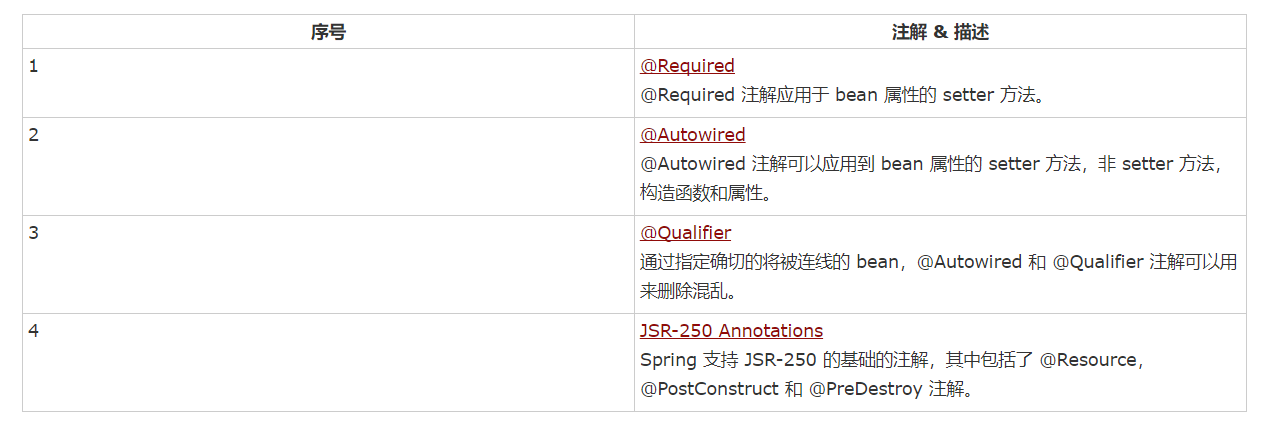基于注解的配置
从 Spring 2.5 开始就可以使用注解来配置依赖注入。而不是采用 XML 来描述一个 bean 连线,你可以使用相关类,方法或字段声明的注解,将 bean 配置移动到组件类本身。
在 XML 注入之前进行注解注入,因此后者的配置将通过两种方式的属性连线被前者重写。

一、@Required注解
@Required 注解应用于 bean 属性的 setter 方法,它表明受影响的 bean 属性在配置时必须放在 XML 配置文件中,否则容器就会抛出一个 BeanInitializationException 异常。下面显示的是一个使用 @Required 注解的示例。
(1)编写Student.java
package com.tutorialspoint; import org.springframework.beans.factory.annotation.Required; public class Student { private Integer age; private String name; @Required public void setAge(Integer age) { this.age = age; } public Integer getAge() { return age; } @Required public void setName(String name) { this.name = name; } public String getName() { return name; } }
(2)编写MainApp.java
package com.tutorialspoint; import org.springframework.context.ApplicationContext; import org.springframework.context.support.ClassPathXmlApplicationContext; public class MainApp { public static void main(String[] args) { ApplicationContext context = new ClassPathXmlApplicationContext("Beans.xml"); Student student = (Student) context.getBean("student"); System.out.println("Name : " + student.getName() ); System.out.println("Age : " + student.getAge() ); }}
(3)编写Beans.xml
<?xml version = "1.0" encoding = "UTF-8"?> <beans xmlns="http://www.springframework.org/schema/beans" xmlns:xsi="http://www.w3.org/2001/XMLSchema-instance" xmlns:context="http://www.springframework.org/schema/context" xsi:schemaLocation="http://www.springframework.org/schema/beans http://www.springframework.org/schema/beans/spring-beans-4.0.xsd http://www.springframework.org/schema/context http://www.springframework.org/schema/context/spring-context-4.0.xsd"> <context:annotation-config/> <!-- Definition for student bean --> <bean id="student" class="com.tutorialspoint.Student"> <property name="name" value="Zara" /> <!-- try without passing age and check the result --> <property name="age" value="11"/> </bean> </beans>
(4)运行MainApp.java中的main方法
如图:

这是正常流程
异常流程只需将Beans.xml改成如下,再运行main方法:
<?xml version = "1.0" encoding = "UTF-8"?> <beans xmlns="http://www.springframework.org/schema/beans" xmlns:xsi="http://www.w3.org/2001/XMLSchema-instance" xmlns:context="http://www.springframework.org/schema/context" xsi:schemaLocation="http://www.springframework.org/schema/beans http://www.springframework.org/schema/beans/spring-beans-4.0.xsd http://www.springframework.org/schema/context http://www.springframework.org/schema/context/spring-context-4.0.xsd"> <context:annotation-config/> <!-- Definition for student bean --> <bean id="student" class="com.tutorialspoint.Student"> <property name="name" value="Zara" /> <!-- try without passing age and check the result --> <!--<property name="age" value="11"/>--> </bean> </beans>
控制台最后的结果如下:

我想大家应该明白了,@Required注解的作用,其实这个注解与input中的required属性倒有其相同点,必填不能为空。
二、AutoWired注解
@Autowired 注释对在哪里和如何完成自动连接提供了更多的细微的控制。
@Autowired 注释可以在 setter 方法中被用于自动连接 bean,就像 @Autowired 注释,容器,一个属性或者任意命名的可能带有多个参数的方法。
演示示例:
1.编写TextEditor.java
package com.tutorialspoint; import org.springframework.beans.factory.annotation.Autowired; public class TextEditor { private SpellChecker spellChecker; @Autowired public void setSpellChecker( SpellChecker spellChecker ){ this.spellChecker = spellChecker; } public SpellChecker getSpellChecker( ) { return spellChecker; } public void spellCheck() { spellChecker.checkSpelling(); } }
2.编写SpellChecker.java
package com.tutorialspoint; public class SpellChecker { public SpellChecker(){ System.out.println("Inside SpellChecker constructor." ); } public void checkSpelling(){ System.out.println("Inside checkSpelling." ); } }
3.编写Beans.xml
<?xml version = "1.0" encoding = "UTF-8"?> <beans xmlns="http://www.springframework.org/schema/beans" xmlns:xsi="http://www.w3.org/2001/XMLSchema-instance" xmlns:context="http://www.springframework.org/schema/context" xsi:schemaLocation="http://www.springframework.org/schema/beans http://www.springframework.org/schema/beans/spring-beans-4.0.xsd http://www.springframework.org/schema/context http://www.springframework.org/schema/context/spring-context-4.0.xsd"> <context:annotation-config/> <!-- Definition for textEditor bean without constructor-arg --> <bean id="textEditor" class="com.tutorialspoint.TextEditor"> </bean> <!-- Definition for spellChecker bean --> <bean id="spellChecker" class="com.tutorialspoint.SpellChecker"> </bean> </beans>
4.编写MainApp.java
package com.tutorialspoint;
import org.springframework.context.ApplicationContext;
import org.springframework.context.support.ClassPathXmlApplicationContext;
public class MainApp {
public static void main(String[] args) {
ApplicationContext context = new ClassPathXmlApplicationContext("Beans.xml");
TextEditor te = (TextEditor) context.getBean("textEditor");
te.spellCheck();
}
}
5.运行MainApp.java中的main方法
结果如下:

@AutoWired 自动装配 它的一个属性叫required,属性值是boolean类型,默认为true,必须,也可以修改为false,非必须。
三、Qualifier注解
可能会有这样一种情况,当你创建多个具有相同类型的 bean 时,并且想要用一个属性只为它们其中的一个进行装配,在这种情况下,你可以使用 @Qualifier 注释和 @Autowired 注释通过指定哪一个真正的 bean 将会被装配来消除混乱。下面显示的是使用 @Qualifier 注释的一个示例。
(1)编写Student.java
package com.tutorialspoint; public class Student { private Integer age; private String name; public void setAge(Integer age) { this.age = age; } public Integer getAge() { return age; } public void setName(String name) { this.name = name; } public String getName() { return name; } }
(2)编写Profile.java
package com.tutorialspoint; import org.springframework.beans.factory.annotation.Autowired; import org.springframework.beans.factory.annotation.Qualifier; public class Profile { @Autowired @Qualifier("student1") private Student student; public Profile(){ System.out.println("Inside Profile constructor." ); } public void printAge() { System.out.println("Age : " + student.getAge() ); } public void printName() { System.out.println("Name : " + student.getName() ); } }
(3)编写MainApp.java
package com.tutorialspoint; import org.springframework.context.ApplicationContext; import org.springframework.context.support.ClassPathXmlApplicationContext; public class MainApp { public static void main(String[] args) { ApplicationContext context = new ClassPathXmlApplicationContext("Beans.xml"); Profile profile = (Profile) context.getBean("profile"); profile.printAge(); profile.printName(); } }
(4)编写Beans.xml
<?xml version = "1.0" encoding = "UTF-8"?> <beans xmlns="http://www.springframework.org/schema/beans" xmlns:xsi="http://www.w3.org/2001/XMLSchema-instance" xmlns:context="http://www.springframework.org/schema/context" xsi:schemaLocation="http://www.springframework.org/schema/beans http://www.springframework.org/schema/beans/spring-beans-4.0.xsd http://www.springframework.org/schema/context http://www.springframework.org/schema/context/spring-context-4.0.xsd"> <context:annotation-config/> <!-- Definition for profile bean --> <bean id="profile" class="com.tutorialspoint.Profile"> </bean> <!-- Definition for student1 bean --> <bean id="student1" class="com.tutorialspoint.Student"> <property name="name" value="Zara" /> <property name="age" value="11"/> </bean> <!-- Definition for student2 bean --> <bean id="student2" class="com.tutorialspoint.Student"> <property name="name" value="Nuha" /> <property name="age" value="2"/> </bean> </beans>
(5)运行MainApp.java对应的main方法

四、Spring JSR-250 注释
Spring还使用基于 JSR-250 注释,它包括 @PostConstruct, @PreDestroy 和 @Resource 注释。因为你已经有了其他的选择,尽管这些注释并不是真正所需要的,但是关于它们仍然让我给出一个简短的介绍。
@PostConstruct 和 @PreDestroy 注释:
为了定义一个 bean 的安装和卸载,我们使用 init-method 和/或 destroy-method 参数简单的声明一下 。init-method 属性指定了一个方法,该方法在 bean 的实例化阶段会立即被调用。同样地,destroy-method 指定了一个方法,该方法只在一个 bean 从容器中删除之前被调用。
你可以使用 @PostConstruct 注释作为初始化回调函数的一个替代,@PreDestroy 注释作为销毁回调函数的一个替代,其解释如下示例所示。
演示示例:
(1)编写HelloWorld.java
package com.tutorialspoint; import javax.annotation.*; public class HelloWorld { private String message; public void setMessage(String message){ this.message = message; } public String getMessage(){ System.out.println("Your Message : " + message); return message; } @PostConstruct public void init(){ System.out.println("Bean is going through init."); } @PreDestroy public void destroy(){ System.out.println("Bean will destroy now."); } }
(2)编写Beans.xml
<?xml version = "1.0" encoding = "UTF-8"?> <beans xmlns="http://www.springframework.org/schema/beans" xmlns:xsi="http://www.w3.org/2001/XMLSchema-instance" xmlns:context="http://www.springframework.org/schema/context" xsi:schemaLocation="http://www.springframework.org/schema/beans http://www.springframework.org/schema/beans/spring-beans-4.0.xsd http://www.springframework.org/schema/context http://www.springframework.org/schema/context/spring-context-4.0.xsd"> <context:annotation-config/> <bean id="helloWorld" class="com.tutorialspoint.HelloWorld" init-method="init" destroy-method="destroy"> <property name="message" value="Hello World!"/> </bean> </beans>
(3)编写MainApp.java并运行对应的main方法
package com.tutorialspoint; import org.springframework.context.support.AbstractApplicationContext; import org.springframework.context.support.ClassPathXmlApplicationContext; public class MainApp { public static void main(String[] args) { AbstractApplicationContext context = new ClassPathXmlApplicationContext("Beans.xml"); HelloWorld obj = (HelloWorld) context.getBean("helloWorld"); obj.getMessage(); context.registerShutdownHook(); } }
结果如图:
